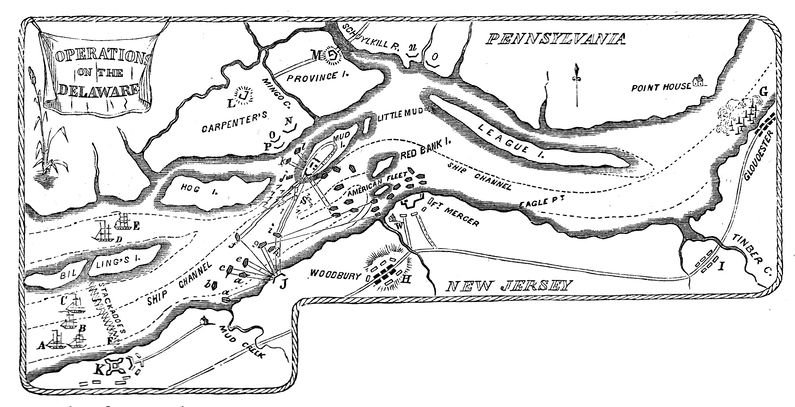Fort Mercer
| More information at Warlike, Wikipedia
Fort Mercer (1777-1781) - A Patriot Revolutionary War fortification established in 1777 in Red Bank, Gloucester County, New Jersey. Attacked by the British in October 1777 and they were repulsed with great losses. Attacked by the British again in November 1777 with superior numbers, abandoned by the patriot defenders. Reoccupied by the Patriots after the British evacuation of Philadelphia in 1778. Named Fort Mercer after Patriot brigadier general Hugh Mercer who was mortally wounded in the Battle of Princton on 3 Jan 1777 and who later died on 12 Jan 1777. Abandoned as a fortification in 1781.
History of Fort MercerA Patriot Revolutionary War fortification established early in 1777 at Red Bank in Gloucester County, New Jersey. Designed by Patriot General Thaddeus Kosciuszko and built as a large earthworks fortification in the spring and summer of 1777 on the east bank of the Delaware River. Directly across the river on Mud Island was Fort Mifflin and in between were underwater obstructions guarded by both forts. This complex was put in place to deny British ships access to Philadelphia and Camden just upriver. The works at Fort Mercer were designed to be defended by 1,500 men but the post was garrisoned by only 500 men. The French engineer Captain Thomas Antoine Mauduit du Plessis downsized the works by building a wall across the inside of the riverside works, making the fort more defendable. The walls of the fort were earthen with a surrounding dry ditch and topped with a log palisade. The fort was about 320 yards long and 50 yards wide and mounted 14 cannons. A separate, but abandoned, outer redoubt was located north of the fort. South of the fort was a substantial house belonging to James Whitall Sr. that became a hospital during the fighting at the fort. Fifteen cannon balls still remain embedded in the north wall of the house from the attacks on the fort. The two forts and the underwater obstructions forced the British to come at Philadelphia from more overland routes and they captured the city on 26 Sep 1777. The forts remained blocking water access to Philadelphia and the British supply lines. Fort Mercer was attacked by some 1,200 British Hessian troops on 22 Oct 1777. The Hessians were repulsed with great losses including their commander Colonel Carl von Donop, 22 officers and 371 men. The downsizing of the defenses played a critical role in the defense success. The Patriot commander, Colonel Christopher Greene, lost only 14 killed and 23 wounded. The fort was then attacked by the British under Lord Charles Cornwallis with 2000 men on 20-21 Nov 1777. The British had reduced Fort Mifflin with a six day bombardment and the survivors had fled over to Fort Mercer. Cornwallis's forces greatly outnumbered the combined Patriot garrisons and they abandoned the fort leaving behind a large quantity of cannon balls and stores. Cornwallis dismantled the fort and demolished the earthworks. The British remained in Philadelphia until 18 Jun 1778 when they evacuated to New York City. The Fort Mercer site was reoccupied by the Patriots after the British evacuation and then abandoned in 1781 when the fighting shifted to Yorktown, Virginia. Current StatusNow a part of the Red Bank Battlefield Park, a Gloucester County park. Monuments, plaques and interpretive signs commemorate and explain the fort's significance. Remains of the earthworks and some artifacts from the underwater obstructions can be seen. The original Whitall House, complete with the fifteen cannon balls still embedded in the north wall, can be toured.
See Also: Sources:
Links:
Visited: No
| ||||||
